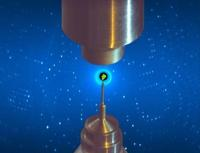Speaker
Description
Rubisco (ribulose-1,5-bisphosphate carboxylase/oxygenase) is responsible for photosynthetic CO2 fixation and is the most abundant enzyme on earth. The carbon atoms in every organism in the entire biosphere have passed through the reaction cycle at the active site of a Rubisco enzyme at some point in time. In the photosynthetic CO2 reduction reaction catalysed by Rubisco, atmospheric CO2 is fixed to a sugar phosphate and the product, 3-phosphoglycerate, is used to build the organic molecules of life. Rubisco is present in most autotrophic organisms including plants, algae, photosynthetic bacteria and cyanobacteria. Both land-based and marine Rubisco are important - oceanic phytoplankton are estimated to provide around 45% of global net primary production.
We have obtained large, well-ordered crystals of spinach Rubisco and performed the first neutron diffraction experiments on crystals of Rubisco from spinach (spinacia oleracea) at IMAGINE (HFIR), MLZ’s Biodiff and MaNDi (SNS). The crystals screened to date have scattered to resolutions of up to 2.1 Å at Biodiff.
Detailed mechanisms have been proposed for how the Rubisco-catalysed reactions may proceed based on high-resolution X-ray structures. While these studies agree on "the big picture", they differ significantly in details such as the movement of electrons and protons. Neutron diffraction may help to visualize protons directly, and this information will be invaluable for efforts to improve carbon fixation catalysis.

